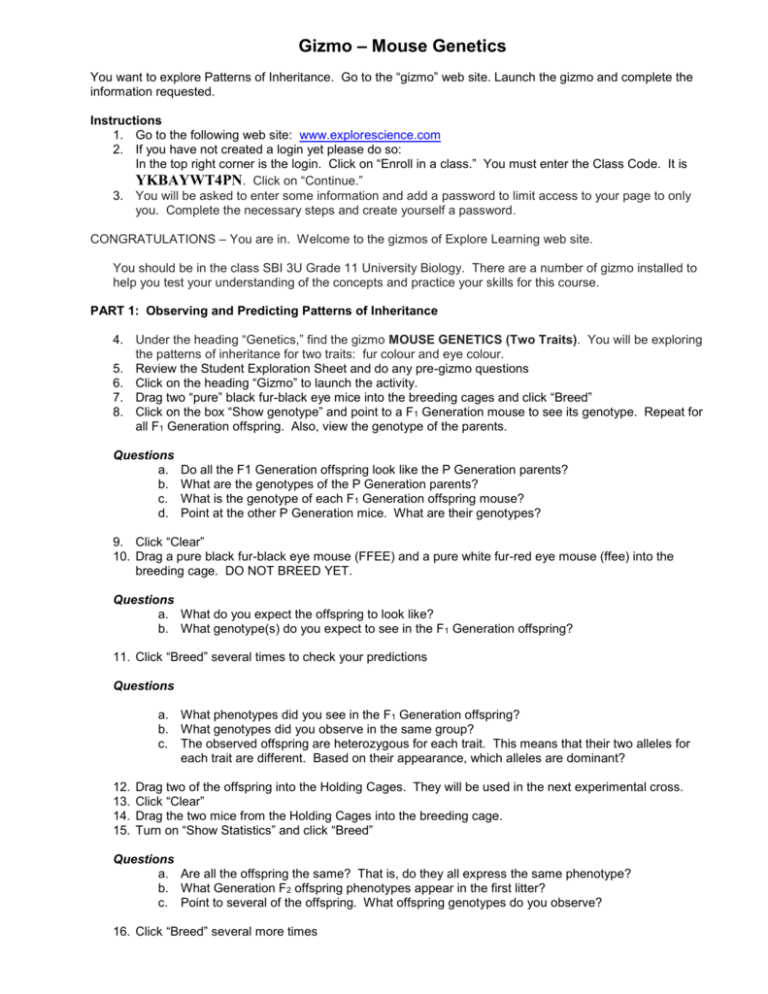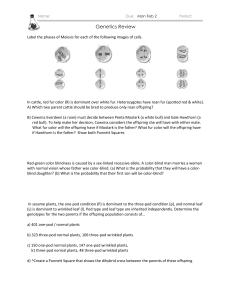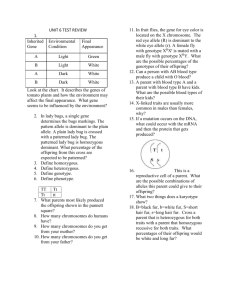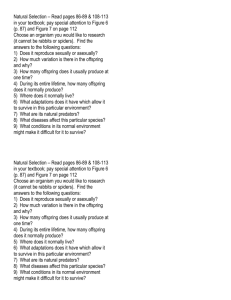Gizmo – Mouse Genetics
advertisement

Gizmo – Mouse Genetics You want to explore Patterns of Inheritance. Go to the “gizmo” web site. Launch the gizmo and complete the information requested. Instructions 1. Go to the following web site: www.explorescience.com 2. If you have not created a login yet please do so: In the top right corner is the login. Click on “Enroll in a class.” You must enter the Class Code. It is YKBAYWT4PN. Click on “Continue.” 3. You will be asked to enter some information and add a password to limit access to your page to only you. Complete the necessary steps and create yourself a password. CONGRATULATIONS – You are in. Welcome to the gizmos of Explore Learning web site. You should be in the class SBI 3U Grade 11 University Biology. There are a number of gizmo installed to help you test your understanding of the concepts and practice your skills for this course. PART 1: Observing and Predicting Patterns of Inheritance 4. Under the heading “Genetics,” find the gizmo MOUSE GENETICS (Two Traits). You will be exploring the patterns of inheritance for two traits: fur colour and eye colour. 5. Review the Student Exploration Sheet and do any pre-gizmo questions 6. Click on the heading “Gizmo” to launch the activity. 7. Drag two “pure” black fur-black eye mice into the breeding cages and click “Breed” 8. Click on the box “Show genotype” and point to a F1 Generation mouse to see its genotype. Repeat for all F1 Generation offspring. Also, view the genotype of the parents. Questions a. b. c. d. Do all the F1 Generation offspring look like the P Generation parents? What are the genotypes of the P Generation parents? What is the genotype of each F1 Generation offspring mouse? Point at the other P Generation mice. What are their genotypes? 9. Click “Clear” 10. Drag a pure black fur-black eye mouse (FFEE) and a pure white fur-red eye mouse (ffee) into the breeding cage. DO NOT BREED YET. Questions a. What do you expect the offspring to look like? b. What genotype(s) do you expect to see in the F1 Generation offspring? 11. Click “Breed” several times to check your predictions Questions a. What phenotypes did you see in the F1 Generation offspring? b. What genotypes did you observe in the same group? c. The observed offspring are heterozygous for each trait. This means that their two alleles for each trait are different. Based on their appearance, which alleles are dominant? 12. 13. 14. 15. Drag two of the offspring into the Holding Cages. They will be used in the next experimental cross. Click “Clear” Drag the two mice from the Holding Cages into the breeding cage. Turn on “Show Statistics” and click “Breed” Questions a. Are all the offspring the same? That is, do they all express the same phenotype? b. What Generation F2 offspring phenotypes appear in the first litter? c. Point to several of the offspring. What offspring genotypes do you observe? 16. Click “Breed” several more times Questions a. What offspring phenotypes are the most common? b. Which phenotypes are the least common? c. Explore the genotypes of different offspring. Is there more than one genotype that codes for the same phenotype? For example, how many different genotypes code for a mouse with black fur and black eyes? How many genotypes can code for a mouse with white fur and red eyes? d. What Generation F2 offspring phenotypes appear in the first litter? PART 1B: Independent Assortment When two events are independent, the probability of both events occurring is the product of probabilities. For instance, the probability of a flipped coin coming up heads twice in a row is ½ X ½ = ¼. As long as two traits are inherited independently, you can use the same rule to determine the probabilities of offspring genotype and phenotype. 17. 18. 19. 20. 21. 22. 23. 24. Click “Clear” Drag a pure black fur-black eye mouse and a pure white fur-black eye mouse into the breeding box. Click “Breed” Drag two of the F1 Generation offspring into the Holding Cages Click “Clear” Drag the two mice from the Holding Cages into the breeding cage Check their genotype. It should be FfEe. Click breed repeatedly until 100 F2 Generation offspring are generated Questions a. What is the percentage of offspring with black fur? b. What is the percentage of offspring with white fur? 25. Complete a Punnett Square to model the inheritance of fur colour alone (i.e., ignore eye colour). Questions a. What is the theoretical probability that an offspring mouse will have black fur? …white fur? Write the probability in fractional form (e.g., 1/5) b. Were your experimental results close to the theoretical probabilities? Were they an exact match? Explain. 26. Another way to predict inheritance of two traits is an expanded Punnett Square. In this case, each parent contributes two alleles to each offspring. In this case, the alleles are fur colour and eye colour. Complete the Punnett Square below. FE Fe fE fe FE Fe fE fe Questions a. Of the 16 offspring in the Punnett Square, how many have black fur and black eyes? (HINT: Look for mice with at least one F allele and one E allele) b. How many offspring have black fur and red eyes? c. How many offspring have white fur and black eyes? d. How many offspring have white fur and red eyes? Investigate the following parent combinations. In each case, use either method to predict the fraction or percentage of each offspring phenotype. Then, use the GIZMO to check your prediction. a. FfEe and ffee c. FfEE and Ffee b. Ffee and FfEe d. FFee and ffEE









